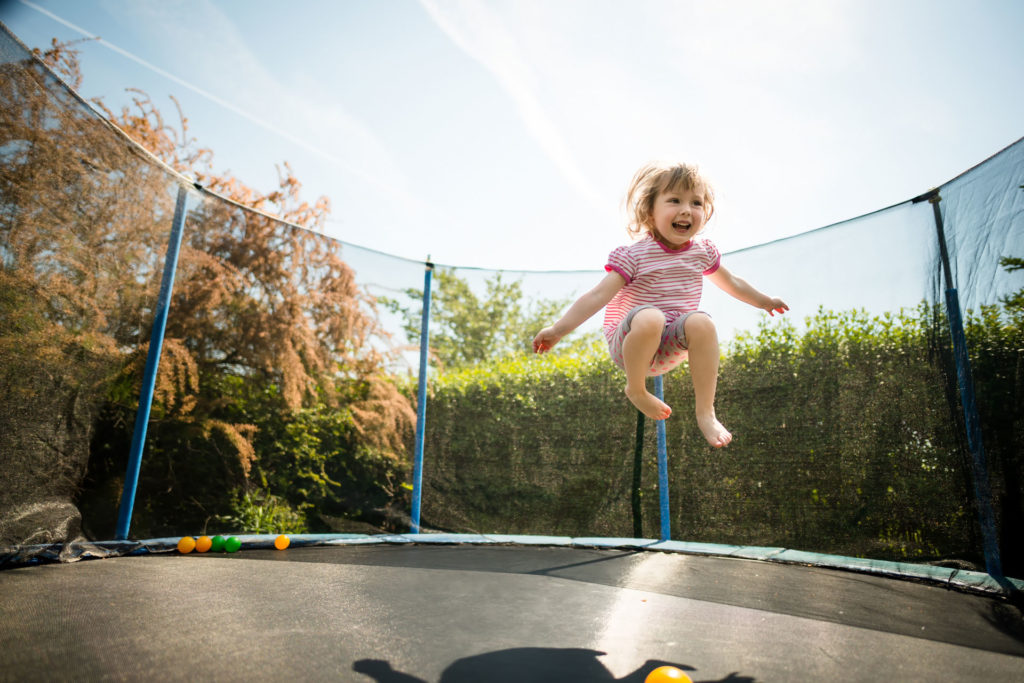Children are full of energy, which adds a burst of liveliness to your life! Their enthusiasm and vigour bring out the best in you. In fact, just observing their happiness hits you with a pang of nostalgia and you can’t help but feel like a kid around them.
If you’re looking for ways to keep your child healthy, active and entertained, then getting a trampoline is the best thing you can do. You’ll be surprised at how they can just jump for hours!
While a trampoline in your backyard can be a great source of recreation for your child, you should know that it can be dangerous as well. In fact, on a yearly basis, around 66% of children suffer from minor or major trampoline injuries. The shocking part is—these injuries occur at home!
Therefore, it is important to follow the safety code when it comes to installing a trampoline in your home for your child. Whether you’re thinking about getting one or already have a trampoline in your house, take a look at some of the safety tips you must practice!
Benefits of a Trampoline
Trampolines are actually great for your child’s health and physical development. According to a study, trampolines:
- Improve inhibitory control
- Boost working memory
- Enhance cognitive flexibility
- Strengthen the bone structure
- Guarantee physical fitness
- Improve co-ordination skills
- Boost motor and cognitive skills development
- Keep your child mentally healthy as it is a great outlet for negative energy, stress and anxiety
Tips for Jumping Safely
As mentioned before, trampolines are a great way for your child to channel their energy but they’re also dangerous. Children can fall off or crash into their partners (if they’re playing with a sibling or mate), which can lead to tiny bruises, sores or injuries. As a parent or guardian, it is your job to enforce some safety rules. Some of the guidelines that you need to follow to ensure your child’s safety are mentioned below.
- Only children over the age of 5-6 years should be allowed on trampolines
- Adult supervision or an adult spotter should always be present while the child is on the trampoline
- Only 1 child at a time should be allowed to prevent the risks of crashing, pushing or shoving
- Discourage stunts that a child may have seen on television without training
- Make sure the child only jumps—somersaults or flips should be prohibited
- Do not let the child jump off the trampoline once their playtime is over. Teach them to sit and slide off the edge gently
- Do not leave a ladder or chair near the trampoline to prevent the child from getting on top of it without adult supervision
- Do not permit the child to play on a wet trampoline
- Make sure to place a safety net or a protective fence around the trampoline to prevent the child from falling off
What’s the Safest Spot to Place a Trampoline?
Apart from following the safety guidelines, it is important to place the trampoline in a secured place. This is why you must:
- Place the trampoline on a flat area. The ground should not have any kind of trenches, bumps of irregularities.
- Keep the trampoline in an area without any risky objects around such as sharp things, metal taps, hedges, trees, pipelines or any kind of plumbing equipment
- Install the trampoline in an energy-absorbing area such as on a sandy or cushioned surface
- Avoid placing the trampoline on a solid surface such as concrete, marble or a wooden floor, especially if it isn’t covered with a safety net
- Make sure to get an 8ft trampoline with enclosure that prevents a child from getting on top of it without supervision or in your absence
How to Make a Trampoline Safe for Your Child?
While there are safety rules that you need to implement and teach your child to follow, there are certain safety measures you need to take in order to make the trampoline a safe zone for your child’s physical activity. These measures include:
- Get an 8ft-round-trampoline as it has a minimum bounce-back effect
- Secure the trampoline with high-rise safety nets properly
- Make sure the trampoline is placed on a leveled surface with proper cushioning
- Make sure the trampoline has shock-absorbing and stabilizing cushioned pads around it (on the surface) to prevent injuries caused by impact
- Make sure the hooks, spring and frame are covered with a cushioned pad
- Make sure the trampoline is located at a safe distance from the buildings, walls, trees, sharp objects and metallic tools
Other Tips
As a parent, it is your responsibility to ensure the safety and well being of your child. While jumping on a trampoline is a harmless activity, not complying with safety rules and regulations can make this activity dangerous.
If you follow all the safety and security tips, your child can engage in this healthy activity without the risks of injuries. Still, it is important to make sure you’re careful and cautious when endorsing this activity.
Some other tips to ensure your child remains safe include:
- Not permitting them to use the trampoline when it is snowing or raining
- Forbidding the use of trampoline if there’s moisture in its base
- Ensuring that your child wears a safety helmet, knee pads and elbow pads if they’re 5 or under
- Train your child to jump in the centre, not the sides
Trampolines are a great way to spend some quality time with your child. You could let them jump while enjoying a little backyard picnic with your friends or significant other. This way, it will be much easier to supervise your child too!

